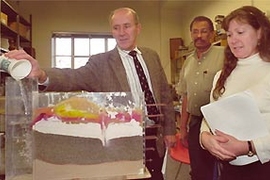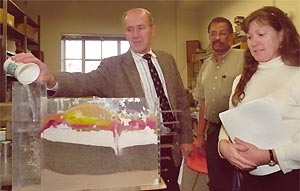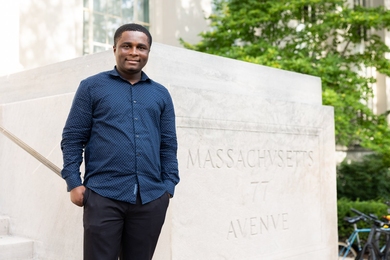CAMBRIDGE, Mass. -- Science teachers from schools around Massachusetts were at MIT this month learning how pollution travels through groundwater and surface water, and performing environmental science experiments they can adapt to suit their own classroom needs.
The 12 teachers, who preside in classrooms from kindergarten through high school, were participants in "Pollutant Transport in Natural Water Systems," a two-day course taught by MIT professors Heidi Nepf and Patricia Culligan of civil and environmental engineering. The course was offered through Teachers as Scholars, a national teacher education program that draws on faculty from MIT and Harvard.
By taking this course and others like it, public school teachers earn points toward recertification (required every five years in Massachusetts), refresh their knowledge, update their skills and recreate the experience of being on the other side of the desk.
Nepf and Culligan volunteer their time and expertise out of a sense of professional responsibility, a love of teaching and also to satisfy the requirements of environmental research grants, many of which now require that up to 30 percent of funding be used for outreach purposes.
As co-directors of educational outreach for the Center for Environmental Health Sciences at MIT, the two have spent countless hours creating a video-tape series for middle and high school students which has now been condensed into a single 33-minute tape with an accompanying curriculum guide. They also worked with a freshman seminar at MIT to create a web-based game called "Consumption Gumption" that teaches people how to make environmentally sound choices at the supermarket. All these projects were funded by the National Institute for Environmental Health Sciences.
"I feel a responsibility to do what I can to improve education at all ages, and in particular in the area of environment, because it impacts everyone," said Nepf.
Using a single topic in environmental science and adapting it for different ages and audiences, she and Culligan have managed to create an outreach program that works for ages five to infinity.
"I'm very passionate about education. I think the better educated everybody is, the better off we all are as a society," said Culligan. "We wanted to try to excite school children about science and get them interested in problems they'll inherit as adults. We need people who are motivated, interested and aware."
ENVIRONMENTAL EXPERIMENTS
On their first day at MIT (Jan. 9), the public school teachers spent the morning in Nepf's classroom learning the movement of pollutants released into surface water such as lakes, rivers and wetlands. That afternoon, they experimented using a wetlands model in a 6-foot aquarium in Nepf's lab. Nepf uses the model to describe the hydrodynamics -- or water movement -- through the shallow water of ponds and wetlands. The students manipulated the model to discover how different factors, like vegetation density, affect water movement and how changes in the pattern of water movement affect the wetland's capacity to absorb and dissipate runoff pollution before it makes its way into the open waters of lakes and oceans.
Their second day (Jan. 16) was spent with Culligan in the Pierce Lab, where they looked at how contaminants move through soil and into groundwater systems. During the morning, the teachers learned how water and contaminants move through groundwater systems. That afternoon in the lab, they first measured the hydraulic conductivities of different soils, then built a model of a cross-section of soils beneath a small farming town, and watched as water moved through the different soils, carrying contaminants along with it.
"The formulas were daunting. Most of us hadn't been expected to use calculus and trigonometry in years. But it was wonderful," said Jim Casserly, who teaches biology and environmental science to high school students at Westford Academy. Casserly appreciated the condensed nature of the course, learning a great deal about the subject in two meetings "instead of investing a semester on a single topic," he said. "And we get no grade. We're there for the pure love of learning."
"This was a way of renewing my undergraduate and graduate work. It's nice to be treated as an intelligent human being and as a peer," said Avis Leabman, a high school biology teacher at Malden. "I teach a unit on the Aberjona River and the way pollution travels in water. I don't think children understand the ramifications of just throwing things out in the backyard."
"This was the most enthusiastic group of students I have taught," said Nepf. "I enjoyed hearing how they would adapt material from the course for their own classes."
"It was pleasure teaching these teachers," said Culligan. "They were full of enthusiasm and asked many thought-provoking questions. I also enjoyed learning how they motivate students and teach science in their own classrooms."
WHAT'S NEXT?
The Teachers as Scholars program was developed as a collaborative project between the Brookline schools and Harvard University, and is now being launched nationally by the Woodrow Wilson National Fellowship Foundation. Approximately 16 MIT faculty participate by teaching seminars in the humanities, social sciences and sciences, helping teachers connect with leading-edge scholarship.
Nepf and Culligan teach their course only once a year, but they plan to use a portion of the curriculum as a unit at MIT's Edgerton Center. Working with teachers from Cambridge Public Schools, the two have prepared a four-hour instruction module for fifth graders that includes building the model of the groundwater system. The children will spend an afternoon at the center working on the topic with their teachers.
"We've designed our instruction module to align with the Massachusetts framework for fifth grade so that teachers can include it in their curriculum. Topics like geology, environment and the impacts of pollution on ecosystems come up in the fifth grade, so this works well," said Nepf.







